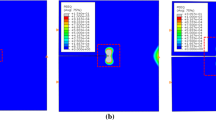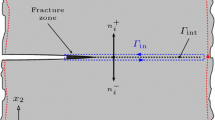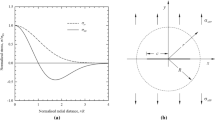Abstract
A computer simulation of the time dependent development of the plastic zone ahead of a crack loaded in uniform tension was performed. The material was assumed to deform according to a creep law relating the local strain rate to the local stress. The plastic zone was modelled by an array of edge dislocations coplanar with the crack. For a given time the stress was found to be uniform in a region ahead of the crack. This region increased and the local stress decreased with increasing time. The distribution of dislocations in the zone at a given time was found to be almost the same as that given by the Bilby, Cottrell and Swinden model (1963) if the friction stress in that model was replaced by an apparent friction stress equal to the uniform stress ahead of the crack. This apparent friction stress is dependent on both the applied stress and time. Assuming a critical crack opening displacement (COD) or a critical value of theJ integral,J c, to be the criteria for the onset of the creep crack growth the initiation time can be calculated using the results of this study. A good agreement between the theory and experiment is obtained for two different CrMoV steels. This comparison with experiments suggests that the COD is an appropriate crack growth initiation parameter for both ductile and brittle materials whilstJ cdoes not seem to be applicable in creep fracture.
Résumé
Une simulation par calculateur du développement fonction du temps de la zône plastique située devant une fissure soumise à tension uniforme a été effectuée. Le matériau est supposé pouvoir se déformer suivant une loi de fluage mettant en relation la vitesse de déformation locale et la tension locale. La zône plastique est représentée par une série de dislocations-coin coplanaires à la fissure. Pour un temps déterminé, la tension a été trouvée uniforme dans la région située de vant la fissure. Cette région s'étend, et la tension locale décroit, lorsque le temps s'accroit. La distribution des dislocations dans la zône à un moment déterminé est trouvée être sensiblement la même que celle donnée par le modèle de Bilby, Cottrell et Swinden (1963), pour autant que la tension de friction dans ce modèle soit remplacée par une tension de friction apparente égale à la tension uniforme située en avant de la fissure. Cette tension apparente de friction dépend à la fois de la contrainte appliquée et du temps. En supposant qu'une valeur critique du COD ou de l'intégraleJ,J cconstitue le critère pour le démarrage d'une fissure de fluage, la durée de l'amorçage peut être calculée en utilisant les résultats de cette étude. Un bon accord entre la théorie et l'expérience a été obtenu dans le cas de deux aciers au CrMoV différents. Cette comparaison avec l'expérience suggère que le COD est un paramètre valable pour l'accroissement d'une fissure dans le cas de matériaux ductiles et de matériaux fragiles, tandis queJ cne paraît pas applicable dans le cas des ruptures dues au fluage.
Similar content being viewed by others
References
D. Hull and D. E. Rimmer,Philosophical Magazine, 4 (1959) 673.
M. V. Speight and J. E. Harris,Met. Science Journal, 1 (1967) 83.
P. T. Heald and J. A. Williams,Philosophical Magazine, 22 (1970) 1095.
J. Weertman,Metallurgical Transactions, 5 (1974) 1743.
R. Raj and M. F. Ashby,Acta Metallurgica, 23 (1975) 653.
R. Raj,Metallurgical Transactions, 6A (1975) 1499.
M. J. Siverns and A. T. Price,Nature, 228 (1970) 760.
K. Robson,International Conference on Properties of Creep Resistant Steels, Düsseldorf, Paper 4.5 (1975).
D. V. Thornton,International Conference on Properties of Creep Resistant Steels, Düsseldorf, Paper 6.5 (1975).
G. J. Neate and M. J. Siverns,International Conference on Creep and Fatique in Elevated Temperature Applications, Philadelphia/Sheffield, Paper C234 (1973/74).
J. D. Landes and J. A. Begley,ASTM Special Technical Publication, 590 (1976) 128.
G. A. Webster,Proceedings of the Conference on Mechanics and Physics of Fracture, Cambridge, Paper 18 (1975).
J. R. Haigh,Materials Science and Engineering, 20 (1975) 213.
J. R. Haigh,Materials Science and Engineering, 20 (1975) 225.
R. D. Nicholson and C. L. Formby,International Journal of Fracture, 11 (1975) 595.
R. M. Goldhof and A. J. Brothers,ASME Journal of Basic Engineering, March (1968) 37.
R. Ohtani, K. Doi, S. Nakamura and A. Nitta,Journal of the Society for Materials Science Japan, 22 (1973) 291.
S. Taira and R. Ohtani,International Conference on Creep and Fatigue in Elevated Temperature Applications, Philadelphia/Sheffield, Paper C213 (1973/74).
A. D. Batte, Private communication (1975).
B. A. Bilby, A. H. Cottrell and K. H. Swinden,Proceedings of the Royal Society, A272 (1963) 304.
N. I. Muskhelishvili,Some basic problems of the mathematical theory of elasticity, P. Noordhoff, groningen, The Netherlands (1953).
V. Vitek,Journal of the Mechanics and Physics of Solids, 27 (1976) 67.
V. Vitek,Proceedings of the Conference on Computer Simulation for Materials Applications, NBS, eds. R. J. Arsenault, J. R. Beeler and J. A. Simmons (1976) 909.
P. T. Heald, G. M. Spink and P. J. Worthington,Materials Science and Engineering, 10 (1972) 129.
G. G. Chell,Materials Science and Engineering, 17 (1975) 227.
G. G. Chell,International Journal of Fracture, 12 (1976) 135.
G. G. Chell and G. M. Spink,Engineering Fracture Mechanics, to be published (1977).
G. G. Chell and A. Davidson,Materials Science and Engineering, 24 (1976) 45.
A. A. Wells,Proceedings of the Crack Propagation Symposium, 1 Cranfield (1961) 201.
A. H. Cottrell,Iron and Steel Institute Special Report, No. 69 (1961) 231.
J. A. Begley and J. D. Landes,ASTM Special Technical Publication, 514 (1972) 1.
V. Vitek,Journal of the Mechanics and Physics of Solids, 24 (1976) 263.
G. D. Branch, J. B. Marriott and M. C. Murphy,International Conference on Properties of Creep Resistant Steels, Düsseldorf, Paper 7.1 (1972).
J. Weertman,International Journal of Fracture Mechanics, 2 (1966) 460.
B. A. Bilby and P. T. Heald,Proceedings of the Royal Society, A305 (1968) 429.
Author information
Authors and Affiliations
Rights and permissions
About this article
Cite this article
Vitek, V. A theory of the initiation of creep crack growth. Int J Fract 13, 39–50 (1977). https://doi.org/10.1007/BF00040874
Received:
Issue Date:
DOI: https://doi.org/10.1007/BF00040874




